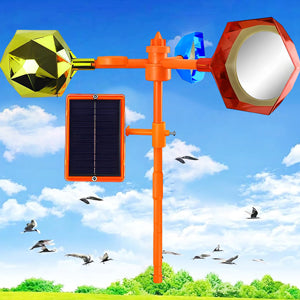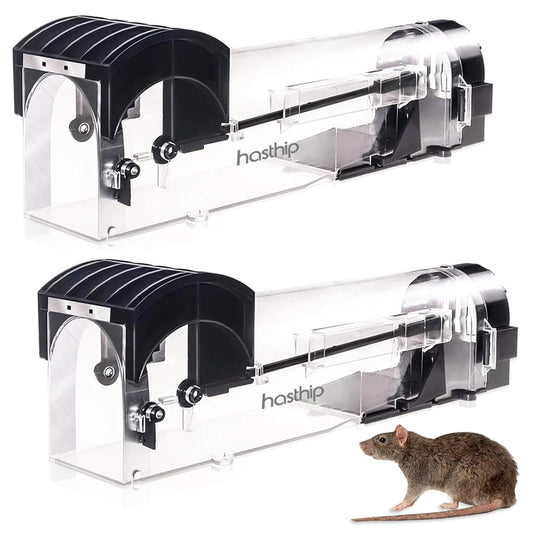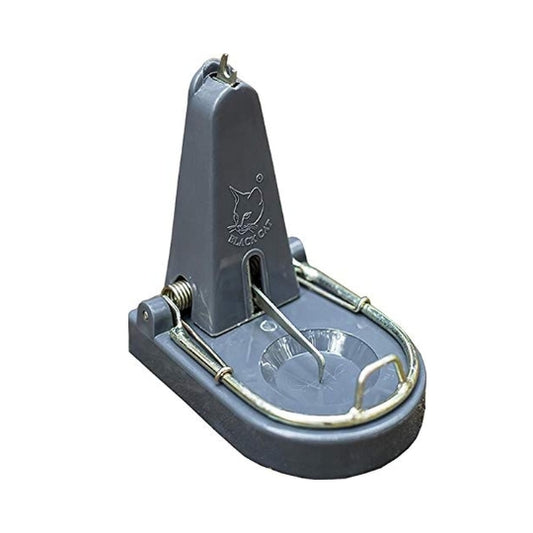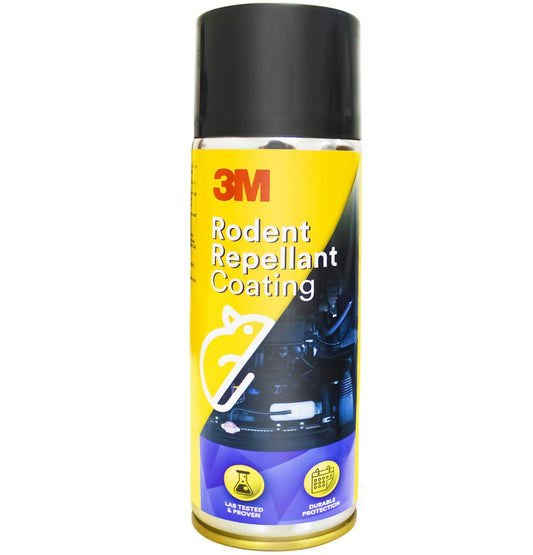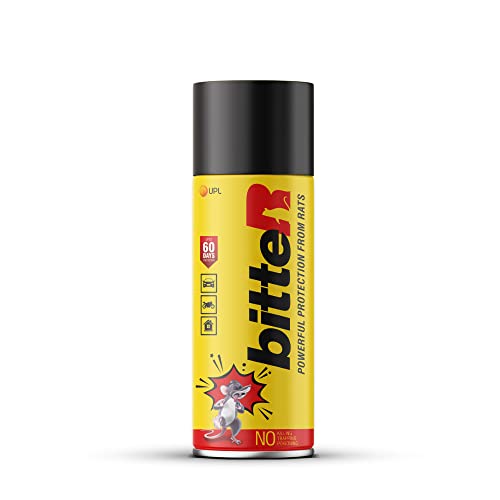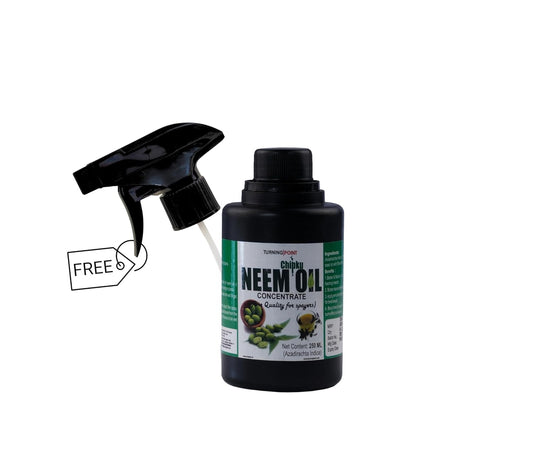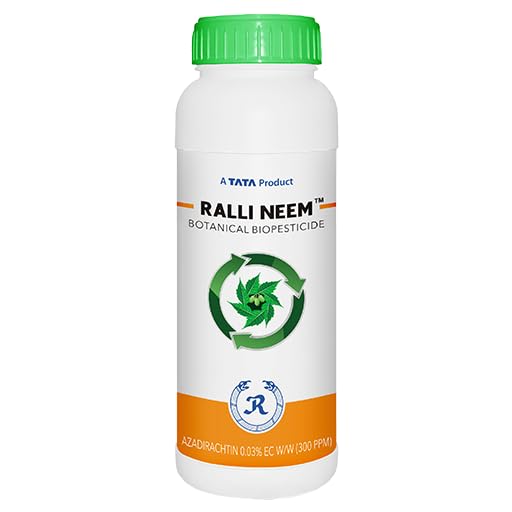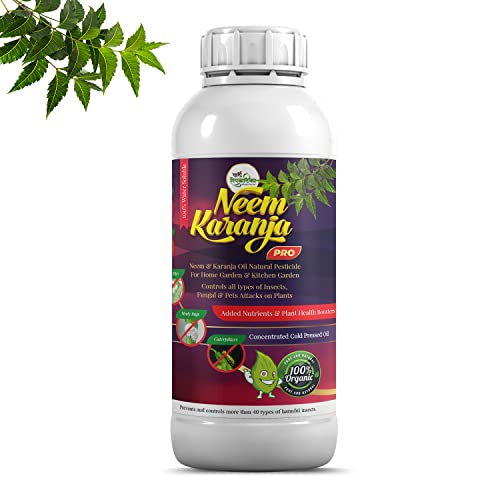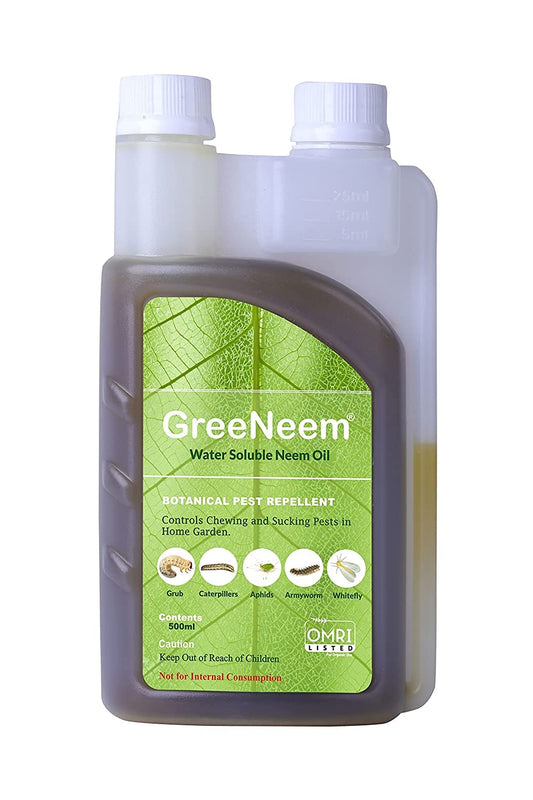
Azadirachtin from Neem Seeds: A Boon for Indian Farmers
Share
Neem, a familiar sight in Indian landscapes, holds a powerful secret weapon against pests: azadirachtin. This natural compound, found mainly in neem seeds, offers an eco-friendly alternative to chemical pesticides. Let's delve into how this valuable ingredient is extracted commercially and its benefits for farmers.
(हिन्दी लेख के लिए नीचे स्क्रोल करे)
Commercial Extraction of Azadirachtin (Neem pesticide):
While traditional methods like grinding neem seeds and making aqueous solutions are effective for small-scale use, commercial extraction involves more sophisticated techniques to obtain concentrated azadirachtin. Here's a glimpse of the process:
- Seed Preparation: Neem seeds are collected, cleaned, and de-pulped to remove the fleshy outer layer.
- Oil Extraction: The seeds are then crushed to extract neem oil, which contains a lower concentration of azadirachtin compared to the seed kernels.
- Solvent Extraction: The remaining seed kernels undergo solvent extraction using organic solvents like methanol or hexane. These solvents dissolve the azadirachtin, separating it from other seed components.
- Purification: The extracted azadirachtin is further purified through various techniques to remove impurities and obtain a highly concentrated form.
Neem Oil vs. Azadirachtin Formulations:
- Neem Oil: This oil, obtained directly from neem seeds, contains a mix of natural compounds, including azadirachtin. It acts as a repellent, insecticide, and fungicide, offering broad-spectrum pest control.
- Azadirachtin Formulations: These products contain purified azadirachtin in higher concentrations, making them more potent and targeted in their action. They are often used in commercial agriculture and come in various forms like emulsifiable concentrates (EC), wettable powders (WP), and granules.
Importance of Azadirachtin:
- Eco-friendly: Azadirachtin is a biodegradable, naturally occurring compound, making it safer for the environment and beneficial insects compared to synthetic pesticides.
- Broad-spectrum control: It effectively controls a wide range of pests, including insects, mites, and nematodes.
- Multiple modes of action: Azadirachtin disrupts insect growth, feeding, and reproduction, making it difficult for pests to develop resistance.
- Reduced residue: It leaves minimal residues on crops, promoting safer food production.
Limitations of Azadirachtin:
- Slower action: Azadirachtin may take longer to show its effects compared to chemical pesticides.
- Sunlight degradation: It can degrade under sunlight, requiring more frequent applications.
- Cost: Commercially formulated products can be more expensive than traditional neem extracts.
Crude Extracts for Farmers:
While commercial formulations are readily available, Indian farmers can prepare their own crude extracts for pest control:
- Aqueous Extract: Grind neem seeds into a fine powder. Mix one part powder with ten parts water and a few drops of liquid soap. Let it soak overnight and strain before spraying on crops.
- Neem Oil Emulsion: Mix neem oil with water and a small amount of emulsifier (like soap) to create a stable emulsion. Spray this solution on plants.
- Leaf Extract: Crush neem leaves and soak them in water for a few days. Strain and use the solution for spraying.
By understanding the benefits and limitations of azadirachtin and utilizing the appropriate methods, Indian farmers can harness the power of neem for sustainable and effective pest management.
भारत में हर जगह पाए जाने वाला नीम का पेड़ कीटों के खिलाफ एक शक्तिशाली हथियार अपने अंदर छुपाए हुए है: अज़ादिराक्टिन। यह प्राकृतिक यौगिक, जो मुख्य रूप से नीम के बीजों में पाया जाता है, रासायनिक कीटनाशकों का एक पर्यावरण-अनुकूल विकल्प प्रदान करता है। आइए देखें कि कैसे इस मूल्यवान तत्व को व्यावसायिक रूप से निकाला जाता है और किसानों के लिए इसके क्या फायदे हैं।
अज़ादिराक्टिन का व्यावसायिक निष्कर्षण:
हालांकि नीम के बीजों को पीसकर और जलीय घोल बनाकर छोटे पैमाने पर इस्तेमाल के लिए पारंपरिक तरीके प्रभावी हैं, लेकिन व्यावसायिक निष्कर्षण में केंद्रित अज़ादिराक्टिन प्राप्त करने के लिए अधिक परिष्कृत तकनीकें शामिल हैं। यहां प्रक्रिया की एक झलक दी गई है:
- बीज तैयार करना: नीम के बीजों को इकट्ठा किया जाता है, साफ किया जाता है, और बाहरी गूदे को हटाने के लिए छील लिया जाता है।
- तेल निष्कर्षण: बीजों को फिर नीम का तेल निकालने के लिए कुचला जाता है, जिसमें बीज की गुठली की तुलना में अज़ादिराक्टिन की कम सांद्रता होती है।
- सॉल्वेंट निष्कर्षण: शेष बीज गुठली मेथनॉल या हेक्सेन जैसे कार्बनिक सॉल्वैंट्स का उपयोग करके सॉल्वेंट निष्कर्षण से गुजरती है। ये सॉल्वैंट्स अज़ादिराक्टिन को घोलकर उसे बीज के अन्य घटकों से अलग कर देते हैं।
- शुद्धिकरण: निकाले गए अज़ादिराक्टिन को अशुद्धियों को दूर करने और अत्यधिक केंद्रित रूप प्राप्त करने के लिए विभिन्न तकनीकों के माध्यम से और शुद्ध किया जाता है।
नीम का तेल बनाम अज़ादिराक्टिन फॉर्मूलेशन:
- नीम का तेल: यह तेल, सीधे नीम के बीजों से प्राप्त होता है, इसमें अज़ादिराक्टिन सहित प्राकृतिक यौगिकों का मिश्रण होता है। यह एक विकर्षक, कीटनाशक और कवकनाशी के रूप में कार्य करता है, जो व्यापक स्पेक्ट्रम कीट नियंत्रण प्रदान करता है।
- अज़ादिराक्टिन फॉर्मूलेशन: इन उत्पादों में उच्च सांद्रता में शुद्ध अज़ादिराक्टिन होता है, जो उन्हें उनकी क्रिया में अधिक शक्तिशाली और लक्षित बनाता है। वे अक्सर वाणिज्यिक कृषि में उपयोग किए जाते हैं और विभिन्न रूपों में आते हैं जैसे इमल्सीफायबल कॉन्संट्रेट (ईसी), वेटेबल पाउडर (WP), और दाने।
अज़ादिराक्टिन का महत्व:
- पर्यावरण के अनुकूल: अज़ादिराक्टिन एक बायोडिग्रेडेबल, प्राकृतिक रूप से पाया जाने वाला यौगिक है, जो इसे सिंथेटिक कीटनाशकों की तुलना में पर्यावरण और लाभकारी कीड़ों के लिए सुरक्षित बनाता है।
- व्यापक स्पेक्ट्रम नियंत्रण: यह कीड़े, घुन और नेमाटोड सहित कीटों की एक विस्तृत श्रृंखला को प्रभावी ढंग से नियंत्रित करता है।
- क्रिया के कई तरीके: अज़ादिराक्टिन कीटों की वृद्धि, भोजन और प्रजनन को बाधित करता है, जिससे कीटों के लिए प्रतिरोध विकसित करना मुश्किल हो जाता है।
- कम अवशेष: यह फसलों पर कम से कम अवशेष छोड़ता है, जिससे सुरक्षित खाद्य उत्पादन को बढ़ावा मिलता है।
अज़ादिराक्टिन की सीमाएँ:
- धीमी क्रिया: रासायनिक कीटनाशकों की तुलना में अज़ादिराक्टिन को अपना प्रभाव दिखाने में अधिक समय लग सकता है।
- सूरज की रोशनी में क्षरण: यह सूरज की रोशनी में ख़राब हो सकता है, जिसके लिए बार-बार आवेदन करने की आवश्यकता होती है।
- लागत: व्यावसायिक रूप से तैयार उत्पाद पारंपरिक नीम के अर्क से अधिक महंगे हो सकते हैं।
किसानों के लिए कच्चे अर्क:
जबकि वाणिज्यिक फॉर्मूलेशन आसानी से उपलब्ध हैं, भारतीय किसान कीट नियंत्रण के लिए अपना स्वयं का कच्चा अर्क तैयार कर सकते हैं:
- जलीय अर्क: नीम के बीजों को पीसकर बारीक चूर्ण बना लें। एक भाग चूर्ण को दस भाग पानी और तरल साबुन की कुछ बूंदों के साथ मिलाएं। इसे रात भर भीगने दें और फसलों पर छिड़कने से पहले छान लें।
- नीम के तेल का पायस: एक स्थिर पायस बनाने के लिए नीम के तेल को पानी और थोड़ी मात्रा में पायसीकारकों (जैसे साबुन) के साथ मिलाएं। इस घोल को पौधों पर स्प्रे करें।
- पत्ती का अर्क: नीम की पत्तियों को कुचलकर कुछ दिनों के लिए पानी में भिगो दें। छान लें और घोल का इस्तेमाल छिड़काव के लिए करें।
अज़ादिराक्टिन के लाभों और सीमाओं को समझकर और उचित तरीकों का उपयोग करके, भारतीय किसान टिकाऊ और प्रभावी कीट प्रबंधन के लिए नीम की शक्ति का उपयोग कर सकते हैं।







